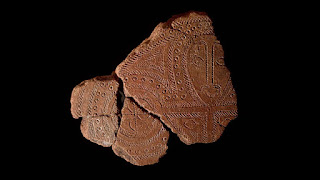AP Art History: Global Pre-History Overview
Saturday, October 1, 2022
Welcome to the first of many time period roundups for AP Art History!
GLOBAL PREHISTORY: 30,000-500 BCE
The 11 works within this content area are split between Paleolithic (old stone age) and Neolithic (new stone age). Below are works from a large section of the world, ranging from cave paintings, the infamous Stonehenge, and multiple interesting sculptures.
The Apollo 11 Stones
Date: 25,500-25,300 BCE
Medium: Charcoal on stone
Period: Prehistoric
This artifact was found by German archeologists in 1969 in Nambia. The archeologists were listening to the radio footage of the Apollo 11 mission when excavating. These two fragments of stones were found 3 years apart, then joined after the second was located. The figure is added to the stone with charcoal.
The Great Hall of the Bulls
Date: 15,000-13,000 BCE
Medium: Rock painting
Period: Prehistoric
Located in the intricate caves of Lascaux, these intricate paintings depict not only bulls but also numerous animals layered over each other. This layering indicates that this area was used over time and multiple generations. The height and overall scale of these paintings would have been extremely difficult to paint, needing some kind of scaffolding. These animals are all shown in 'twisted perspective', meaning that their bodies are shown in profile but the horns are shown frontally.
Camelid Sacrum
Date: 14,000-7,000 BCE
Medium: Bone
Period: Prehistoric
Created from the sacrum or tailbone of an alpaca related animal, this object is very perplexing. Found in the Valley of Mexico, it is deliberately sculpted and smoothed. Like with all objects created before writing, it is impossible to truly know the reason and significance with which this was sculpted. Many believe it later related to Mayan Canine gods/goddesses.
Running Horned Woman
Date: 6000-4000 BCE
Medium: Pigment on Rock
Medium: Pigment on Rock
Period: Neolithic
First, it is important to note that the above image is the restored version of this painting. I encourage you to do some research on what the non-reconstructed version is.
Found in the Tassili region of Algeria, situated in the Sahara Desert, this rock painting is very interesting. Once again, twisted perspective is used in not only the figure in the foreground but also all of the other characters in the background. The central figure is a very intricate and confusing image, with a horned headdress, traditional dress, and maybe some traditional tattooing. Many believe that she may be a goddess, due to the possible rain cloud near her headdress.
Beaker with Ibex Motifs
Date: 4200-3500 BCE
Medium: Painted Terra Cotta
Period: Neolithic
This piece of pottery's most distinctive characteristics are the three registers, all filled with highly stylized animals. The most noticeable register includes an ibex or mountain goat with very decorative horns. All three registers shift these animals into geometric shapes, making this object not only interesting from an archeological perspective but also from an artistic one. The other two registers include a breed of dog and a bird.
Anthropomorphic Stele
Date: 4th millennium BCE
Medium: Sandstone
Period: Neolithic
This near-human, low relief sculpture is thought to have perhaps been a funerary marker. The double dagger on the waistband was very characteristic of this period. Over sixty-five of these steles were found. A stele is a singular, large piece of stone or wood, engraved in relief with an image or text of some kind.
Created in Neolithic China, there were hundreds of these congs found in graves along with bi (disks made from jade). Their purpose is unknown, but archeologists know that they must have been a fairly long standing custom due to their multitude. Jade is a notoriously hard material and during Song China, machines to cut this material had not been created. This means that all sculping was done by abrasion.
The Ambum Stone
Date: 1500 BCE
Medium: Greywacke
Period: Neolithic
While being used by Natives of Papua as a ritual object, New Guinea, this sculpture was taken from its place of origin. Its original purpose is again unknown, but many think that perhaps it was used as a mortar and pestle by holding the nose and grinding with the bottom.
Tlatilco Female Figurine
Date: 1200-900 BCE
Medium: Ceramic
Period: Neolithic
Found in large quantities in a burial setting, this figure is one of many but has a very interesting defining factor: the two faces. The Tlatilco village was a pre-Columbian culture who settled in the Valley of Mexico. It was the setting of the Aztec Empire 2000 years later. The coloring of this sculpture, hair details, hands, and feet set it apart from its counterparts. As a collective, these figures pose the same question as many pieces of Prehistory art: What were the religious beliefs of this culture? Many scholars point to this sculpture as an emphasis in duality, light and dark, and good and evil.
This fragment comes from the Lapita culture in the Philippines. Pacific island culture such as this Filipino one are famous for their symmetric, stylized tattoos. This piece of terra cotta is believed to have been part of a very large design. It includes an anthropomorphic face, geometry, and cross hatching.
Stonehenge
Date: 2500-1600 BCE
Medium: Sandstone
Period: Neolithic










